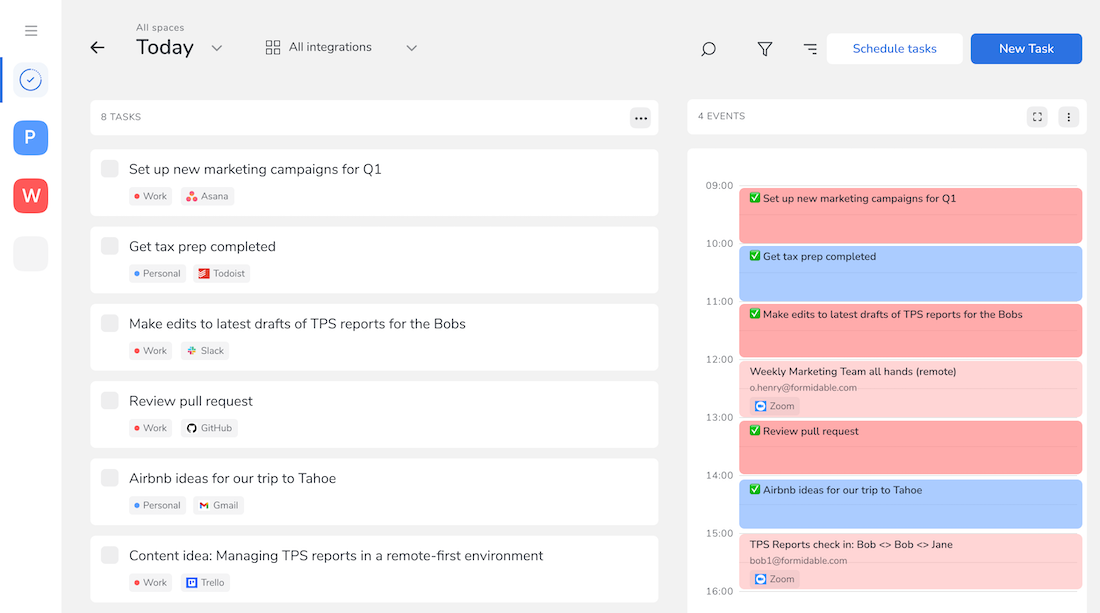How to Prioritize Tasks at Work
Struggling with how to prioritize tasks at work? We cover methods and tools for staying focused, including Ivy Lee, Eisenhower matrix, and more.
When we first started working on Taskable, we spent a lot of time talking to prospective users about their routine for how to prioritize tasks at work. We found that many people struggle with prioritization. During our interviews, when we asked about their day-to-day, we got responses like:
‘I’m not sure I’m making an impact’
‘I’m constantly overwhelmed’
‘I have so much to do it’s hard to decide what to do next’
‘My day is chaos’
We often have so much to do in such a small amount of time that it's overwhelming. The day-to-day grind can be disconnected from the bigger picture. Is what I am doing at this very moment helping me achieve what I want to achieve this week? This month? This year? If you struggle with this, you’ve come to the right place. Here we’ll discuss various methodologies and tools for prioritizing tasks and your time at work.
Eisenhower Matrix
A popular method for how to prioritize tasks at work is the Eisenhower matrix. Named for the 34th president, this methodology has you sort all your tasks into a two by two grid of urgent/not urgent and important/not important.
The idea is all those in the top left corner (urgent and important) are the ones you do yourself immediately. In the top right corner (important but not urgent) are tasks you schedule to do down later. In the bottom left (urgent but not important) are items you can delegate to someone else. Finally, in the bottom right (not urgent and not important) are tasks you can eliminate. One problem with the Eisenhower matrix is when you have too many important and urgent tasks in a given day. How do you decide among the several in the top left quadrant on what to do next?
Learn more about the Eisenhower matrix
The Ivy Lee Method
Developed back in the early 1900s by Ivy Lee, founder of modern public relations, this methodology has you write down the six most important things you can work on the next day, in order of impact.
The next day at work, start with the top item and don’t stop until it is finished. Then move on to the next thing until it’s complete. Then the next. What’s great about this methodology is it is simple and forces you to focus on one thing at a time. The Ivy Lee method also takes the guesswork out of what to start on first the next morning. We love the Ivy Lee planning and its emphasis on one thing at a time. However, it’s not without its flaws. For one - how do you decide among the many things to do what the most important is? Additionally, what about repetitive tasks you need to get done, such as answering emails or Slack messages?
Learn more about the Ivy Lee method
Getting Things Done
Developed by David Allen, the Getting Things Done (GTD) method was a huge inspiration for many when he first published it in the early 2000s. The workflow has five stages:
- Collect - get all the things you need to do into an inbox or written down somewhere so you can close the loop on it and it’s not stressing you out anymore
- Process - triage everything in your inbox, and decide if it is actionable and what the next action needs to be
- Organize - add tasks to where they need to be. Appointments go into your calendar. With projects (things that require more than one next step), put them in a project list, and decide on the next actionable step. For single-action steps, put them in your subsequent actions list. And things you are blocked on, write down what you are waiting for before you can complete the task,
- Reflect - Regularly review your lists, make sure everything is up to date.
- Engage - What you decide to do next.
One issue with GTD is the amount of overhead it takes to manage this process. Also, it requires a relatively large shift in habits for many people - you have to make a significant investment in changing your habits to get the most out of it.
Learn more about Getting Things Done
Taskable
Of course, we think Taskable is a great way to prioritize tasks at work! And we take a bit from each of these various methodologies. We push you towards the high leverage items from the Eisenhower matrix by setting an effort and impact for each task.
From Ivy Lee, we help you plan your day around your top priorities, making it easy to select the six things from the top of your to-do list to work on in a given day. From Getting Things Done, we have an inbox feature where you can triage new tasks and put them into their order of importance. We let you park things in the someday list, and break projects into smaller steps or next actions. We also integrate with your work tools to make it easy to capture and write everything down in one place.
Summarizing how to prioritize tasks at work
To summarize these various methodologies, there are a few commonalities among them:
- Focus on impact - think critically about each task you have in front of you, and focus on the most impactful ones
- Plan - take the time to outline your day or even your week. Look through all the work you have in front of you, and be ruthless with where you decide to spend your time.
- Write things done - either physically or digitally, have the things you need to get done written down, so you can see them, prioritize them, and plan them.






